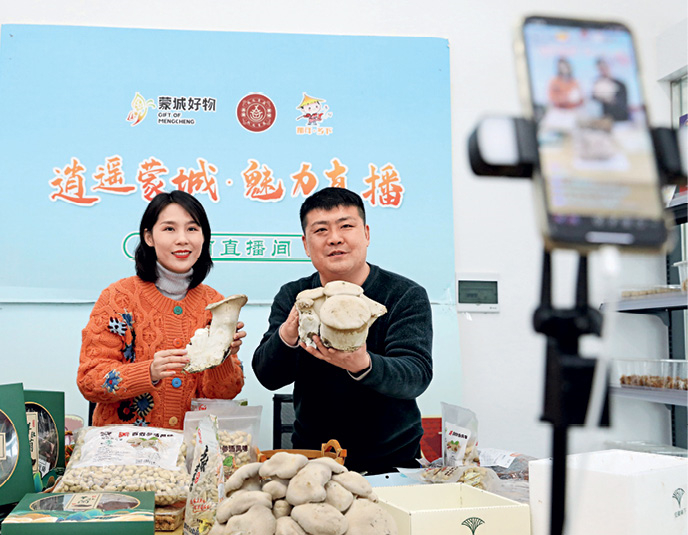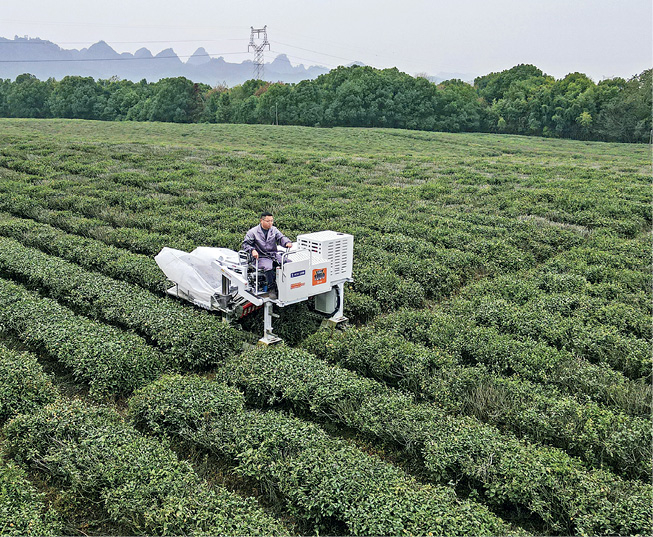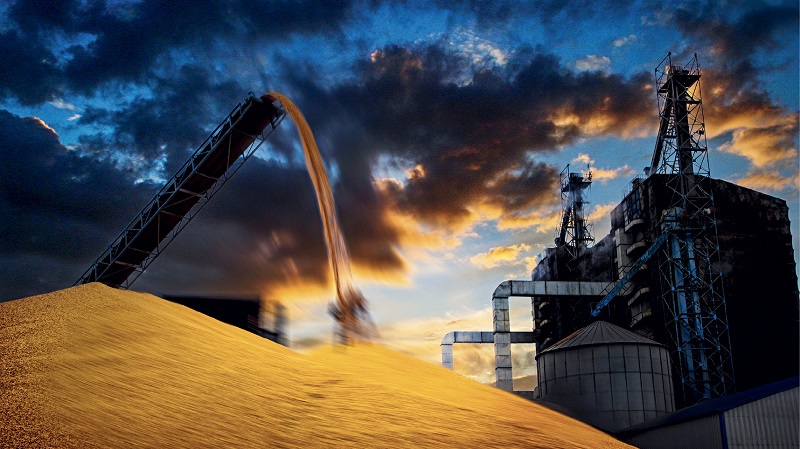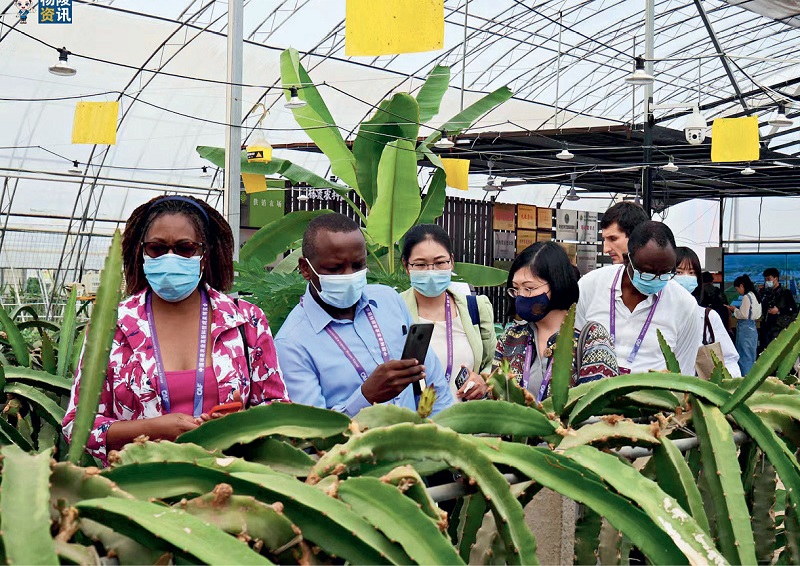China is advancing rural revitalization through multiple channels, and various deputies at the 2023 “two sessions” shared their views on its future development.

E-commerce live-streamers carry out a special promotion activity for rural revitalization in Bozhou City of Anhui Province on February 10, 2023.
Rural revitalization is essential to China’s national rejuvenation. At the central rural work conference held last year, President Xi Jinping stressed the importance of strengthening the efforts of the government in areas relating to agriculture, rural areas, and farmers to vigorously promote the modernization of agriculture and rural areas.
While delivering the government work report at the first session of the 14th National People’s Congress (NPC) on March 5, Premier Li Keqiang pointed out several priorities to stabilize grain output and advance rural revitalization in 2023, including keeping the total grain acreage at a stable level, ramping up the development of high-standard cropland, facilities for irrigation, water conservancy, and other agricultural infrastructure, and invigorating the seed industry, supporting the development of agricultural science, technology, and equipment. Besides these, rural industries that produce local products should be fostered to create more channels for increasing rural incomes, and the achievements in poverty alleviation should be consolidated and expanded to prevent large-scale relapse into poverty.

The first tea plucker independently developed by Zhejiang Provincial Agricultural Machinery Research Institute is conducting a tea-plucking test in Jinhua City of Zhejiang Province on December 14, 2022.
Ensuring Grain Security
Over the past five years, China refined policies to support grain production, stabilized subsidies for grain growers, and set minimum purchase prices for rice and wheat at reasonable levels. Rewards for major grain-producing counties were increased and the policy-based agricultural insurance system was improved. Meanwhile, China strengthened the protection of cropland, launched an initiative to protect chernozem soils, improved water conservancy infrastructure, and increased the area of high-standard cropland by 30.4 million hectares.
China also developed agricultural belts for ensuring food security and accelerated the pace of innovation in seed technology and agricultural machinery and application of new research advances. The rate of mechanization in the plowing, planting, and harvesting of crops increased from 67 percent to 73 percent.
Wu De, NPC deputy and president of Sichuan Agricultural University, has been working on a plan for China’s grain security and rural revitalization based on his efforts over the years of serving the agriculture needs of Sichuan Province. Recently, Sichuan Agricultural University collected 220 questionnaires regarding the difficulties met by major grain growers across Sichuan. Sichuan Agricultural University will study up on how to help them overcome these difficulties. Over the past two years, Wu’s work has focused on building a higher-level “Tianfu (another name of Sichuan) granary” in the new era. The university has launched two programs powered by technology to achieve that end. It has further pooled science and technology, education, and talent resources, and carried out scientific and technological research to help Sichuan become a region strong in agriculture.
The “No. 1 central document” for 2023 once again put food security first and called for enhanced efforts to stabilize production and ensure the supply of grain and important agricultural products. Wu is much encouraged by this statement. “The core of highlighting food security is to standardize the whole industrial chain of grain production through a series of mechanisms and systems so as to ensure abundant grain supplies,” he said.
Recently, on the Chengdu Campus of Sichuan Agricultural University, Wu De invited some experts in the fields of law and grain to jointly discuss and offer advice on grain security legislation. He indicated that currently, there is no specific law dedicated to ensuring gain security, instead, relevant stipulations are scattered in other laws and executive regulations. China should take more rapid steps to make and pass the grain security protection law as soon as possible.
Wu has also been paying attention to the construction and protection of seed breeding bases. “The seed industry is like the chip of agriculture. Now, 11 national breeding bases in Sichuan Province are facing various problems like low levels of mechanization and poor facilities,” Wu said. He hopes to receive greater help in talent training and policy support through legislation, so as to ensure the healthy development of the seed industry and that the rice bowls of the Chinese people are firmly held in our own hands.
Jiang Changyun, researcher and deputy director of the Institute of Industrial and Technological Economics of the China Academy of Macroeconomic Research, said it is imperative to resolve two issues as China accelerates the process to become a strong agricultural country. First, China has a large population, so it is of great significance to ensure the stability and secure supplies of grain and major agricultural products for the 1.4 billion Chinese people. This not only means producing enough food but also seeing to it that China is independent concerning food security. Second, a major agricultural power has relatively great competitive advantages and strong competitiveness in global agricultural competition. It is vital for agricultural policies to better promote innovation, competitiveness, and sustainable development of the agricultural industry, which is also important in the pursuit of high-quality development in the modernization of China.
Jiang believes that even though China’s agriculture sector enjoys a sound foundation, judging by global standards, it still lags behind some agricultural powers in terms of agricultural development level, agricultural brands, and cross-country agro-industrial organizations. There is still a long way to go to build up China’s strength in agriculture. It requires comprehensive efforts and the participation of people at all levels of society.

Last year’s bumper harvest sees a large amount of corn that is dried, stored, and loaded in trucks for sale on March 2, 2023.

Digitally Empowered
“Rural revitalization must be digitally empowered and digital professionals are needed for high-quality development,” stressed President Xi while attending a deliberation with his fellow deputies from Jiangsu Province at the first session of the 14th NPC on March 5.
“During the 14th Five-Year Plan period (2021-2025), the transition to digital life and consumption patterns will reshape the rural market, the integration of rural e-commerce elements will accelerate, and the huge potential of rural e-commerce for promoting agricultural production and rural consumption will be accelerated,” said Zhao Wanping, NPC deputy and vice president of the Anhui Academy of Agricultural Sciences. Zhao suggested that government agencies at all levels actively encourage and strengthen guidance for digital consumption, establish a long-term mechanism for collaboration between industries, universities, and research institutes, and empower rural revitalization by fostering a digital agricultural economy.
China’s online retail sales of farm produce reached RMB 531.38 billion in 2022, up 9.2 percent year-on-year, according to data from the Ministry of Commerce. The growth rate increased 6.4 percent from that of 2021. In 2022, online retail sales in the country’s rural areas rose 3.6 percent year-on-year to RMB 2.17 trillion. Rural e-commerce has played an important role in promoting agricultural product sales, helping rural revitalization, and empowering the digital transformation and industrial upgrading.
In regards to how to further strengthen the development of digital agriculture, Zhao suggested expanding the scope of digital applications and exploring digital solutions for agricultural production areas. For example, the scale and technological advantages of the platform economy should be brought into play, and the digital transformation of agriculture should be promoted in the agro-industrial belts. Efforts should be made to promote the integration and application of a new generation of information technology such as the Internet of Things, big data, artificial intelligence, and robots in all aspects of agricultural production and processing.
This year’s government work report declared to improve the express delivery system in rural areas. Zhao suggested that investment in agricultural infrastructure should be increased to solve the blockage of agricultural product logistics. It is necessary to accelerate the construction of infrastructure facilities such as water conservancy, highways, and agricultural production and processing in rural areas. A digital village system should be built to continuously reduce logistics costs through scale effects and model innovation.
“The digital transformation of agriculture needs to cultivate more new farmers who understand both agriculture and e-commerce. It is necessary to cultivate digital agricultural professionals and establish a training system of new farmers and new agricultural business,” said Zhao. He also believes that vigorous efforts should be made to carry out training for rural talent in various fields and college-graduate village officials who can play a leading role in building a better-off countryside.
“The rural digital industry will also offer huge employment opportunities. The key to realizing the modernization of agriculture and rural areas depends on talent, especially digital talent,” said Ye Meilan, NPC deputy and president of Nanjing University of Posts and Telecommunications. Building digital villages is of strategic importance for rural revitalization and is an important part of building a digital China. In recent years, with the rapid development of Internet technology, technologies such as the Internet of Things, cloud computing, and big data have been integrated into agricultural production, rural construction, and governance, constantly generating a driving force for rural development.

Foreign participants are walking through a greenhouse at the 29th China Yangling Agricutural Hi-tech Fair after it opens in Yangling Demonstration Zone, Shaanxi Province on September 15, 2022.
Boosting Rural Revitalization and Development
Xi also stressed the necessity of placing industrial revitalization as the top priority of rural revitalization, and actively extend and expand the industrial chain in the agricultural sector. China needs to foster and develop new industries and new forms of business in rural areas and broaden channels for farmers to increase their income and enjoy a prosperous life.
Industrial development is a significant foundation for the comprehensive revitalization of rural areas. Without high-quality industries, rural economic and social development will become “water without a source.” While safeguarding the red line of farmland, China advances rural revitalization by pursuing sustainable development, transforming traditional planting to modern planting, and enhancing food security through intensive cultivation. All parts of China explore local resource endowments, create brands of characteristic industries, develop agriculture with regional signatures, and enhance the core competitiveness of their agricultural sector.
“By cultivating rice, we have helped farmers in surrounding regions increase their income. We also explore the digital planting mode, apply digital management of farms to improve management efficiency, and ensure stable and high yields,” said Wei Qiao, NPC deputy and chairwoman of the Yongxing Agricultural Machinery Mechanization Specialized Cooperative in Zhenjiang City, Jiangsu Province. As a master of soil science, she and her husband, a doctor of agronomy, resigned from the Chinese Academy of Sciences and Peking University respectively, and have worked in the countryside ever since 2017.
According to Wei, the objective of their work now is bringing the knowledge they mastered in scientific research institutes to the field, developing circular agriculture, improving the agricultural ecosystem, and implementing digital management. By promoting agricultural brand building and integration of the primary, secondary, and tertiary sectors through scientific and technological empowerment, the efficiency of agriculture and the added value of agricultural products are improved, attracting more young people to devote themselves to rural revitalization and the cause of building China into an agricultural power.
Gao Chunyan, NPC deputy and director of the Agricultural Technology Promotion Center of Muling City, Heilongjiang Province, said that the formation of rural characteristic agricultural products is often closely related to the geographical conditions and folk customs of various places. She believes that it is timely to turn local specialties and niche brands into large industries that are able to raise farmers’ income. With the continuous improvement of people’s living standards, their food consumption needs are also increasingly diversified. In recent years, the large-scale planting of characteristic agricultural products adapted to local conditions has increased, and the supply-side demand has shown an upward trend.
Gao suggested more guidance for farmers’ professional cooperatives and family farms and support for niche brands built with cooperatives as the main body. She also underscored measures to encourage rural residents to set up small and micro processing enterprises, extend the industrial chain of characteristic agricultural products, integrate production, processing, and marketing, create a virtuous circle of rural economy, and promote farmers’ income.
It is necessary to create the development model of “characteristic agriculture + income-increasing projects,” and strengthen the integration of agriculture with processing and circulation, leisure tourism, culture and sports, science and technology education, health and wellness, and e-commerce.